FRANCE
Avignon

Avignon
Avignon
Avignon is a city and municipality in the southeast of France. Avignon is the capital of the Vaucluse department and borders the left bank of the Rhône River. The historic center with the medieval ramparts has been well preserved. The entire old town is under the protection of UNESCO as a World Heritage Site. According to the 2010 census, there are 94,787 residents in the city. Of these, 12,000 inhabitants live in the old center of the city. The city is a famous center of art and culture. The Avignon Festival, the annual theater festival, is known far beyond the borders of France.
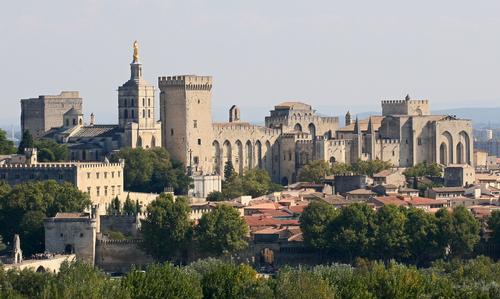 AvignonPhoto: Jean-Marc ROSIER CC 3.0 Unported no changes made
AvignonPhoto: Jean-Marc ROSIER CC 3.0 Unported no changes made
| advertisement |
| Hotels Avignon |
Location
Avignon is located on the left bank of the Rhône, a few kilometers above the confluence with the Durance, about 580 km southeast of Paris, 229 km south of Lyon and 85 km northwest of Marseille. The coordinates of Avignon are: 43° 57 North latitude and 4° 49 East longitude. Avignon is set in a large oval-shaped area, with many beautiful, well-kept parks and gardens. The historic center is bordered by city walls.
Weather
Avignon has a Mediterranean climate with relatively dry summers and cool, damp winters. There is often a lot of wind, the strongest wind is the mistral. The coldest months are November, December, January and February. The hottest months are June, July and August. The average highest temperature is 20 °C per year, the average lowest temperature is 8.9 °C per year. The annual precipitation is 617 mm, most of the rain falls in autumn and winter.
History
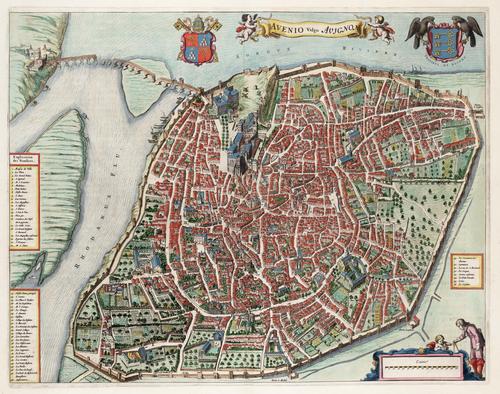 Avignon map from1663Photo: Public Domain
Avignon map from1663Photo: Public Domain
Avignon has been inhabited since the Neolithic. This is evidenced by finds at Rocher des Doms. In Celtic times there was a fortress and a harbor. In the first century BC, the Romans conquered Avignon. It was then known under the name Avenio. Due to its strategic location on a trade route, the ancient city grew considerably.
After the fall of the Roman Empire, Avignon was alternately attacked and conquered by the Goths, Vandals and the kingdoms of Burgundy and Arles in the 5th century. Later Avignon fell to the Saracens.
In 1033 Avignon came under the influence of the Holy Roman Empire. The prosperous twelfth-century Avignon is growing enormously due to an increase in trade and industry. The Saint-Bénézet bridge built between 1177 and 1185 attracted many visitors. At the end of the twelfth century, Avignon declared itself an independent republic, but it lost its independence again in 1226 during the Albigensian Crusade.
Avignon came into the possession of the popes in 1274. In 1303 Pope Bonifatic VIII founded the University of Avignon. In 1309, Pope Clement V chose Avignon as his residence and from March 9, 1309 to January 13, 1377, Avignon was the seat of the papacy instead of Rome. This caused disharmony in the Catholic Church. Seven Popes stayed there: Pope Clement V, 1305-1314; Pope John XXII, 1316-1334; Pope Benedict XII, 1334-1342; Pope Clement VI, 1342-1352; Pope Innocent VI, 1352-1362; Pope Urban V, 1362-1,370 and Pope Gregory XI, 1370-1378. These popes built the "Palais des Papes". This immense Gothic building, with walls from 17 to 18 meters thick, was built from 1335 to 1364 on a natural rock.
In the centuries that followed, the French kings constantly sought to incorporate the city into their kingdom. But it would take until May 1814 before the annexation by France was recognized by the popes. The city fell into disrepair. In 1801 the city had only 20,000 inhabitants, in 1906 there were already 48,000. During the two world wars many people were killed and injured. After the war, the city mainly presented itself as a cultural and tourist destination.
Sights
The most interesting part of Avignon is the old town surrounded by its defensive walls. There are a number of grandiose historical monuments. The buildings along the main street, Rue de la Republique, belong to the period of the Second Empire (1852-1870) with façades by the architect Haussmann around the main square. The neoclassical town hall and theater district are well worth a visit. There are interesting statues in Place de l'Horloge, the main square of the city.
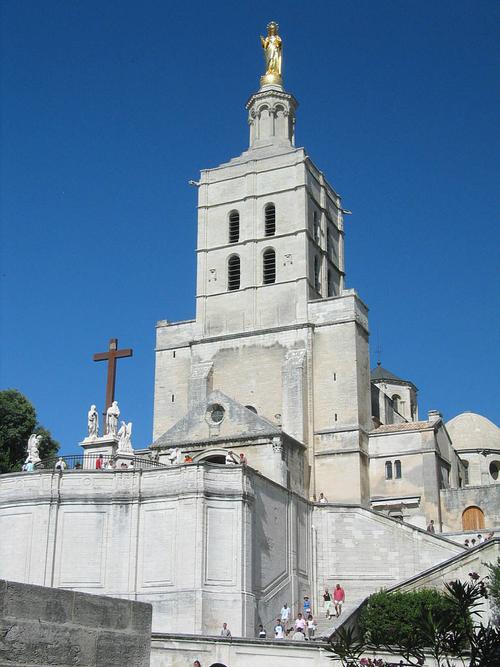 Notre Dame des Doms AvignonPhoto: Rolf Süssbrich CC 3.0-licentie no changes made
Notre Dame des Doms AvignonPhoto: Rolf Süssbrich CC 3.0-licentie no changes made
Notre Dame des Doms is the unique cathedral from the 12th century, built in Romanesque style. Its most striking feature is the gilded statue of the Virgin Mary on the west tower. The Mausoleum of Pope John XXII is one of the most beautiful works of art in the cathedral. It is a remarkable example of 14th century Gothic carvings.
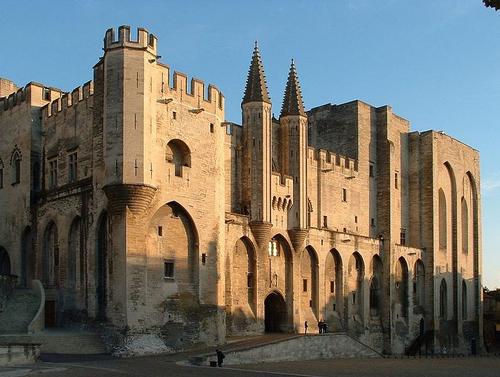 Avignon Palais des PapesPhoto: Chimigi CC 2.0 Frankrijk no changes made
Avignon Palais des PapesPhoto: Chimigi CC 2.0 Frankrijk no changes made
The Palais des Papes ("Papal Palace") is an impressive structure. John XXII began its construction in 1316 and successive Popes completed it in 1370.
There are notable public buildings such as the Hôtel de Ville (town hall) with a bell tower from the 14th century, and the old Hôtel des Monnaies (the papal mint) built in 1610 and later transformed into a music school.
One of the finest examples of medieval fortifications that still exist are the ramparts, built by the Popes in the 14th century. The ramparts are still around Avignon. These strong walls with thirty-nine massive towers and several city gates have been beautifully restored.
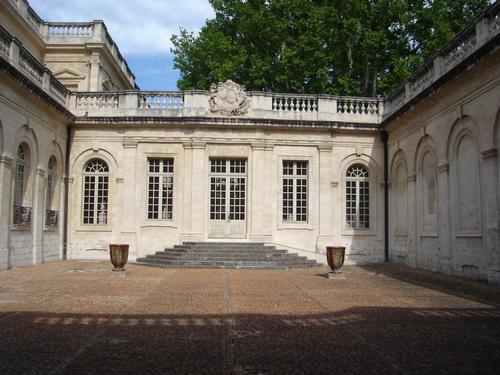 Calvet Museum AvignonPhoto:Shoshanah CC 2.0 General no changes made
Calvet Museum AvignonPhoto:Shoshanah CC 2.0 General no changes made
There are also a number of interesting museums in Avignon. Such as the Calvet Museum, named after Esprit Calvet, a doctor who donated his collections to the city in 1810. This museum has a rich collection of paintings, metal artifacts and a library with more than 140,000 volumes. The Musee du Petit Palais (opened in 1976) overlooking the Palais des Papes, has an exceptional collection of paintings from the Avignon school. The Lambert Collection is famous for its contemporary art. The Musee Lapidaire, with the archaeological and medieval sculpture collections, is located in the old chapel of the Jesuit College.
Tips
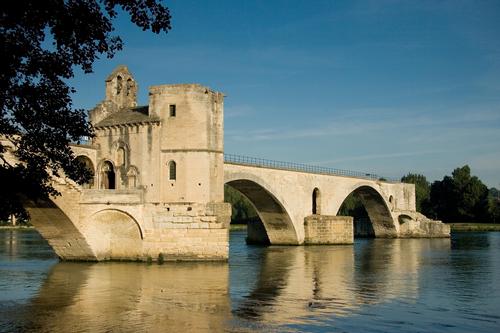 Avignon BridgePhoto: Charles Greenhough CC 3.0 Unported no changes made
Avignon BridgePhoto: Charles Greenhough CC 3.0 Unported no changes made
Bridges are Avignon's trademark. A small bridge over the river leads to Villeneuve-les-Avignon and there are picturesque ruins of the bridge from the 12th century Pont Saint-Benezet. The Pont d'Avignon (Pont St-Benezet) is the famous bridge with only four of the eighteen pylons left. The bridge is best known for the famous French song Sur le pont d'Avignon.
A famous theater festival is held annually in Avignon. The Avignon Festival has existed since 1947. There are traditional theatrical events as well as other art forms such as dance, music and film. Good use is made of the city's historical monuments. Every summer, this festival attracts more than 100,000 people to Avignon.
Useful links Avignon
BBC Country ProfilesWorld Fact Book Explore all Countries
How to call
Last updated June 2025
Copyright: Team - The World of Info